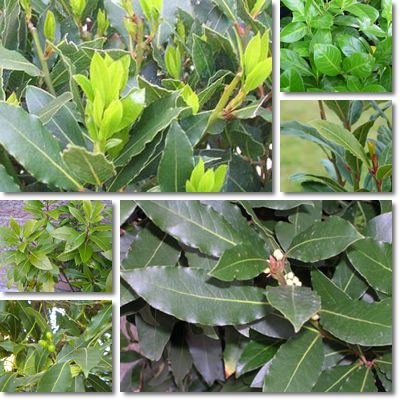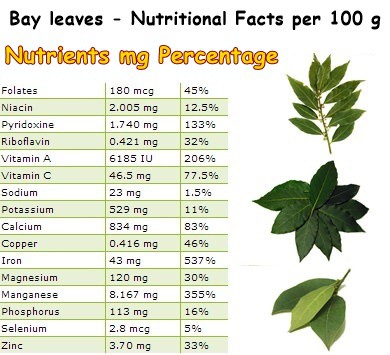Worshiped as the tree of the Sun God, the bay laurel tree (Laurus nobilis) was highly appreciated both as a culinary spice and as a medicinal herb during Roman and Greek antiquity. Bay leaves were used to crown the heads of great poets and philosophers or winners of ancient Greek game tournaments, hence the expressions to rest on one’s laurels, to look to one’s laurels or to assume the laurel. Although the symbolism has been lost, bay leaves preserve their outstanding nutrient profile which makes a great addition to any diet.
Rich in essential oils, the leaves offer relief for a variety of medical conditions from digestive discomfort and muscle aches to respiratory problems. Bay leaves are an excellent source of vitamins A and C as well as iron, manganese, calcium, copper and zinc. Their nutritional profile recommends them for eye and bone health, inflammatory conditions and anemia prevention. They boast impressive antioxidant properties and contribute to good immunity, among other benefits.

What do bay leaves look like?
As you can see from the images from above and below, bay leaves are deep green-gray, shiny, smooth, elongated, pointy leaves. You might not expect it, but they are also quite stiff for fresh leaves, and downright tough when dried. Bay leaves are not normally eaten, just used to add flavor to various dishes.
What do bay leaves taste like?
Fresh bay leaves have a mild leafy fragrance and a bitter taste. Dried ones are significantly more fragrant (the essential oils having had time to set), but slightly sweeter in taste. Their fragrance is reminiscent of thyme or oregano with which they share several essential oils such as eugenol. However, dried bay leaves are even more stiff and abrasive than fresh ones so it might be best to remove them from stews, soups, sauces or other vegetable or meat dishes prior to serving them.
Why remove bay leaves from food prior to serving it?
Are they toxic if eaten? Seen that we use them to flavor our food, they are not toxic at all. However, as mentioned above, bay leaves are quite abrasive, rough. Swallowing either a piece or a smaller leaf whole might either bruise the esophagus, stomach or intestines or perforate the intestines, a severe health issue which requires immediate medical attention.
Bay leaves may also get stuck in the throat and cause the person having eaten them to choke. In order to avoid unnecessary trips to the emergency room, it is recommended to take the leaves out of the food prior to serving it. Also, you might want to use bay leaves whole when cooking; this way they are easier to spot and remove. But what are bay leaves actually good for?

What are the benefits of bay leaves?
See below the list of the top 10 properties and health benefits of bay leaves:
Antifungal and antiseptic properties
Bay leaves are rich in essential oils: cineol (50%), alpha-pinene, beta-pinene, myrcene, limonene, linalool, methyl chavicol, neral, alpha-terpineol, geranyl acetate and eugenol. Research suggests that these natural aromatic oils show excellent antifungal and antiseptic properties. Eucalyptol especially is a potent antifungal agent, hence its addition to multiple mouthwash products. Eugenol is shown to inhibit Listeria monocytogenes, a bacterium known to cause meningitis in newborn babies (but does not constitute treatment for it). Add to this the high zinc content (33%) of the leaves and you get great immune system support.
Analgesic and anti-inflammatory effect
Myrcene (also found in lemon grass) and eugenol (also found in cloves, cinnamon and nutmeg) boast great analgesic and anti-inflammatory properties, hence their extensive use in stress reduction therapies and dentistry. Find out the benefits of your favorite herbs and spices on the herbs and spices page.
Anticancer properties
Eugenol extracted from bay leaves has shown excellent anticancer activity, destroying several types of colon cancer cells. Limonene was shown to be efficient against certain types of brain cancer cells. Lauroside, a compound extracted from bay leaves, has been shown to inhibit the proliferation of skin cancer cells. Bay leaves are also rich in potent antioxidants such as vitamin C, copper and manganese, which scavenge for free radicals, preventing them from damaging cells and DNA.
Benefits for stress relief
Linalool and myrcene, also found in hemp, were shown to have mild sedative effects thanks to which they provide stress relief. While eating food flavored with bay leaves might not relieve your stress, drinking lemon balm, lemon grass or verbena tea might. However, regular bay leaf oil massages will help improve circulation and induce a pleasant state of calm. You can use it for massaging your temples and relieve headache pain.

Digestive relief
Traditional medicine recommends bay leaves for relieving flatulence (stomach gas), treating colic and soothing ulcer pain and heartburn. Personally, I find lemon balm, dandelion and nettle far better choices for relieving stomach pain associated with acid reflux and heartburn, indigestion, gastritis and ulcer.
Pain relief
Bay leaf oil boasts excellent anti-inflammatory properties and can thus be used to relieve muscle and arthritis joint pain. However, consumption alone may not provide sufficient relief. Applying poultices or rubbing the essential oil on affected areas might provide more relief.
Benefits for respiratory problems
Traditional medical practices recommend drinking bail leaf tea to reduce cold and flu symptoms and help improve more severe respiratory problems such as bronchitis. Being a potent anti-inflammatory, antibacterial and antiviral agent (good vitamin C content), bay leaves represent an excellent natural treatment for bacterial and viral infections of the respiratory tract. However, consulting a doctor is mandatory.
Stimulate immunity
Bay leaves are a rich source of vitamins A and C as well as zinc, three nutrients of great importance for a strong, healthy immune system. Vitamin A (206%) ensures the health of mucous membranes found at the level of the eyes, nose, mouth, throat, lungs and digestive tract, directly exposed to bacteria and viruses. If healthy, these mucous membranes do not permit viruses and bacteria to penetrate them and breach our immune defense. Vitamin C (77.5%) is probably the most potent antibacterial and antiviral agent ever discovered, strengthening our immune system and supporting its functions.
Incredible mineral content
Being rich in calcium (83%), bay leaves promote strong bones and teeth by preventing bone loss and supporting bone development. Iron (537%) is excellent against anemia. Copper (46%) and manganese (355%) help prevent premature hair graying, iris discoloration and support thyroid hormone production.
Bay leaves for beautiful hair and skin
Bay leaf oil is an excellent anti-inflammatory and skin emollient. It can be used for both dry skin and dry scalp. Moreover, due to its strong antibacterial properties, it is said to help with cuts, rashes and insect bites. Also, it makes a great tonic for dry, dull hair, restoring shine and strength. Traditionally, bay leaf oil was used to treat dandruff, combat hair loss and help remove head lice. Leaves were boiled in water (1 part leaves to 4 parts water) and left to act for about 3 hours. Alternatively, bay leaf oil was applied directly on the scalp and left for at least 1-2 hours, then rinsed. The procedure was repeated until all lice and their eggs were removed.
Also read about the benefits of bay leaves for diabetes.
Conclusion
Overall, bay leaves boast an impressive nutritional profile and have both external and internal uses. Regular consumption is believed to provide antioxidant, anticancer and antibacterial protection, stimulate immunity, fertility and help improve rheumatism and arthritis pain. However, too much of anything can do more harm than good, so remember to limit your consumption to small amounts and do not eat the whole leaves. Pregnant women are often advised to avoid consuming laurel on a regular basis because of the the possibility of it causing a miscarriage.
